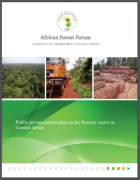The African Forest Forum (AFF) commissioned this study in four of the ten countries in Central Africa (Cameroon, Democratic Republic of Congo, Gabon and the Republic of Congo) as part of its activities funded by the Swedish International Development Agency (Sida) through a project entitled “Strengthening Sustainable Forest Management in Africa”. The project seeks to generate and share knowledge and information through partnerships in ways that will provide inputs into policy options and capacity building for improved forest management in order to better addresses poverty eradication and environmental protection in Africa. Central Africa is well-endowed with forests, covering 48% of the total land area of 530 million ha. Four countries (Cameroon, Congo, DRC and Gabon) were purposefully selected for this study because together they constitute about 87% of the forest in Central Africa and representing all biophysical landscapes. The methodology for data collection included focus group discussions, interviews with key informants and desk reviews of relevant reports including draft reports that were prepared by national consultants from the 4 selected countries, policy and legislative information related to the sector from various websites and scientific articles. Timber-based and NTFP-based enterprises were targeted to identify stakeholders and beneficiaries, the challenges and the probable future for value addition to forest products and their marketing. Based on the study results some recommendations are proffered to policy makers (specific to forest/product type) and others for further research on public/private partnerships for both processed wood and NTFPs in Central Africa. The results indicate that in Central Africa, six forest management models exist and have their merits and demerits depending on the primary beneficiary (private sector, councils, communities or private individuals) and the socioeconomic focus of national governments to increase stakeholder participation in sustainable forest management or to ensure an increased financial contribution of the forestry sector to the country’s GDP. It was observed that forest concessions form the dominant forest management model in Central Africa, with total surface of 7 058 958 ha in Cameroon, 13 685 971 ha in the Republic of Congo, 12 215 659 ha in the Democratic Republic of Congo (DRC) and 14 272 630 ha in Gabon. Emphasis is also given on other evolving models of forest management such as community forests, council forests, sale of standing volumes and special permits based on mutual understanding between the public and the private individual or enterprises. In addition to PPPs under production forests in Central Africa, other forms are evolving in protected areas (mostly World Heritage Biospheres sites) in the Democratic Republic of Congo (DRC), the Republic of Congo and Chad but with yet immeasurable positive attributes. However, one qualitative positive attribute in the Odzala-Kokoua National Park in DRC is linked to deliberate involvement of other stakeholders such as local communities in the development of ecotourism activities. Also examined is the contribution of the forestry sector to national income and employment as well as national trade balances associated with the export and importation of key wood products. Further analyses are made on trade aspects, in terms of efficiency in flows to various continents, the types of products exported; and finally some recommendations are proffered, including on the need for increased value addition within the countries and further research support for the generation of scientific evidence to support policy decision making.

